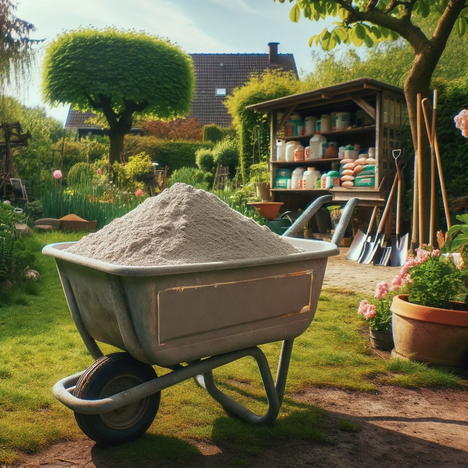Phosphate fertilizer

Phosphate fertilizers are fertilizers that contain phosphorus, an important nutrient for plants. Phosphorus is involved in many processes in plant metabolism, such as energy production, cell division, flower formation and seed formation. Without phosphorus, plants cannot grow and reproduce.
Phosphate fertilizers are available in various forms and compositions. Some are mineral, others organic or organic-mineral. The most important phosphate fertilizers are
- Superphosphate: A mineral fertilizer made from rock phosphate and sulphuric acid. It contains around 20 % phosphorus in water-soluble form and is fast-acting.
- Thomas phosphate: A mineral fertilizer obtained from the by-product of steel production (Thomas slag). It contains around 10 % phosphorus in a poorly soluble form and is slow-acting.
- Bone meal: An organic fertilizer consisting of crushed animal bones. It contains about 15 % phosphorus in a poorly soluble form and is slow-acting.
- Guano: An organic fertilizer made from the excrement of seabirds or bats. It contains around 10 % phosphorus in a water-soluble form and is fast-acting.
- Compost: An organic fertilizer consisting of plant or animal waste. It contains around 1% phosphorus in a poorly soluble form and is slow-acting.
How to apply phosphate fertilizer correctly
The application of phosphate fertilizer depends on various factors, such as the needs of the plants, the content of the soil, the pH value of the soil and the time of year.
- The plants' requirements vary depending on the species, variety, growth phase and expected yield. In general, flowering and fruit plants have a higher requirement than green and root plants. Young plants also require more phosphorus than older plants.
- The content of the soil can be determined by a soil analysis. The optimum phosphorus supply is around 50 to 100 mg/kg of soil. If there is a lack of phosphorus, the plants often show dark green to bluish leaf coloration, reduced vigor, delayed flowering and lower fruit quality.
- The pH value of the soil influences the availability of phosphorus in the soil. At an acidic pH value (below 6), phosphorus is easily leached out or bound to aluminum or iron. At an alkaline pH value (above 7), phosphorus is bound to calcium or converted into poorly soluble compounds. The optimum pH value for phosphorus absorption is around 6 to 6.5.
- The time of year determines the timing of fertilization. Most plants need phosphorus primarily at the start of growth in spring or when sowing or planting. Therefore, phosphate fertilizer should preferably be applied in autumn or winter so that it is worked into the soil by spring.
The amount of phosphate fertilizer depends on the needs of the plants and the content of the soil. A rule of thumb is to use around 50 to 100 g of superphosphate, 100 to 200 g of Thomas phosphate, 150 to 300 g of bone meal, 50 to 100 g of guano or 2 to 4 kg of compost per square meter. However, the amount of fertilizer should always be adapted to the individual conditions.
What you should bear in mind when using phosphate fertilizers
Although phosphate fertilizers are useful for plants, they can also have negative effects if used incorrectly or excessively. These include:
- Environmental pollution: An excess of phosphorus in the soil can enter the groundwater or bodies of water through rainfall or irrigation and lead to eutrophication. This means that the water loses oxygen due to excessive algae growth and other living organisms die off. To avoid this, phosphate fertilizer should only be applied as required and in appropriate quantities. In addition, a sufficient distance from bodies of water should be maintained.
- Health hazard: Some phosphate fertilizers can be harmful to humans or animals if they are ingested or inhaled. This applies in particular to mineral fertilizers, which may also contain other substances such as fluorine, heavy metals or radioactive elements in addition to phosphorus. To avoid this, phosphate fertilizers should only be handled with gloves and a face mask. Contact with skin, eyes or mucous membranes should also be avoided. In the event of poisoning, a doctor should be consulted immediately.
- Plant damage: A lack or excess of phosphorus can lead to growth disorders or deficiency symptoms in plants. This applies in particular to sensitive plants such as orchids, rhododendrons or blueberries, which have a low phosphorus requirement. To avoid this, phosphate fertilizer should only be applied after a soil analysis and taking into account the type and variety of plant. In addition, the fertilizer should be evenly distributed and well worked into the soil.
Phosphate fertilizers are an important source of phosphorus for plants that need this nutrient for their growth and development. There are various types of phosphate fertilizers that differ in their composition, effect and application. To use phosphate fertilizers correctly, you should consider the needs of the plants, the content of the soil, the pH value of the soil and the time of year. You should also avoid the possible negative effects of phosphate fertilizers on the environment, health and plants.
If you notice any signs of hypersensitivity or poisoning in your dog, you should see your vet immediately. We are not a substitute for a vet, but we try to be as accurate as possible. Every dog reacts differently and we recommend you get a second opinion or consult your vet if in doubt.
Stay healthy and take good care of your four-legged friend!😊